Neil Gaiman MasterClass Review:
Can It Help You to Start Writing Fiction?
Last updated on: May 20, 2023, Written by:
Bill Tremlon
Just a heads up, whenever possible, I use affiliate links in my reviews to help cover the costs of running this site. You can learn more here.

As a lifelong fan of contemporary fiction, I’m curious about the creative process of the genre masters. J.R.R. Tolkien is no longer around to give us his insights, but we have Neil Gaiman, and I was thrilled to try his MasterClass.
I think all fiction lovers should be excited about this course. That’s why I wrote this Neil Gaiman Masterclass Review. It’s all about the course’s uniqueness and structure. I will also share my personal opinion on whether this writing class is worth the money.

Contents
Neil Gaiman’s MasterClass Overview
Gaiman provides all the necessary tools for fiction writers. From basics, such as character development and finding ideas, to pushing your story beyond a single genre and tips on how to overcome writer’s block. Neil Gaiman Masterclass is balanced for beginners, but every seasoned writer will find value in it too.
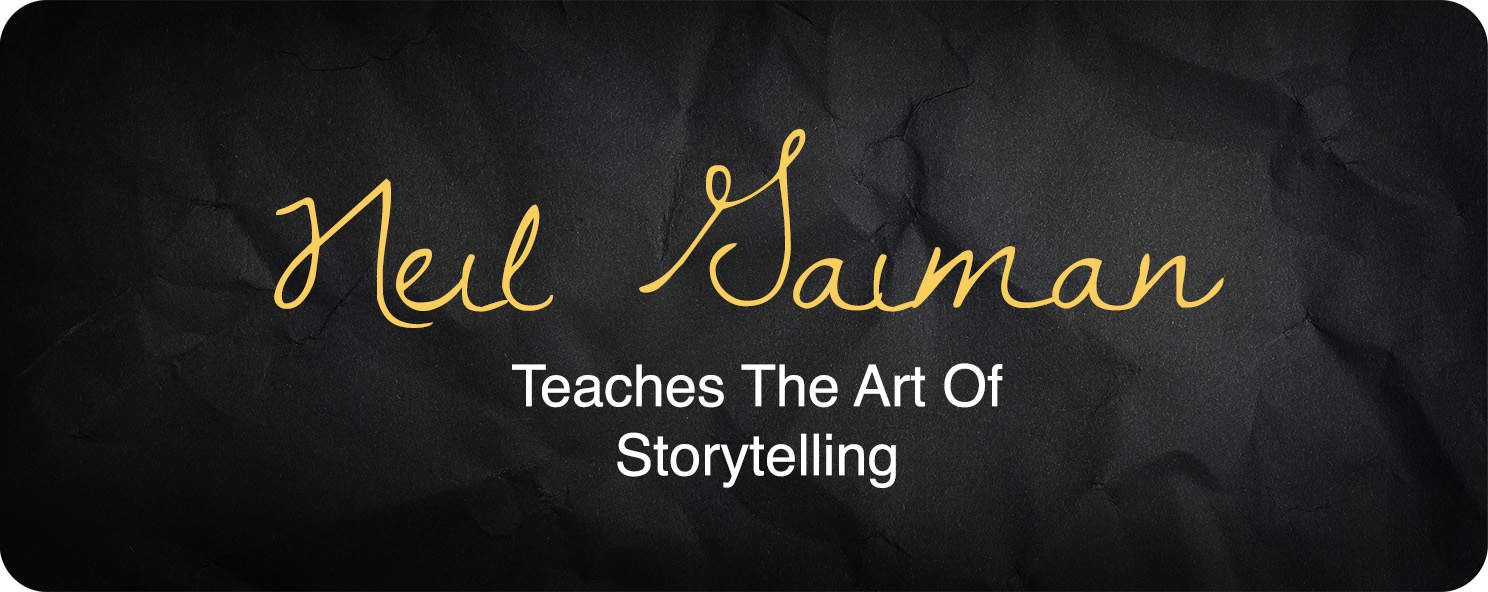
Neil Gaiman MasterClass Review Summary
| ⭐ Rating: | 9.4 ★★★★★ |
| 🥇 Category of class: | Writing |
| 📈 Suits best for: | Anyone interested in fiction and writing |
| 🕒 Lenght: | 4 Hours 49 minutes |
| ⏳ Avg. Lesson Duration | 15 minutes |
| 🛍️ Course Essentials: | Pen, paper, and love for fiction writing |
| 💼 Complementary material: | Neil Gaiman’s books |
| 📚 No. of Lessons: | 19 lessons |
| 🛒 Payment options: | Individual / Duo / Family |
| 💵 Price: | 10 – 20 $ (billed annually) |
| 🔄 Refund policy: | 30-day satisfaction guarantee |
| 🎁 Free trial: | ✅ |
Key Skills You’ll Learn
- Finding big ideas for stories;
- Building fictional yet “real” worlds;
- Creating compelling characters and writing dialogue;
- Recognizing and breaking literary genres;
- Editing texts;
- Ways to overcome writer’s block.
Who is Neil Gaiman’s MasterClass for
Neil Gaiman’s Masterclass focuses on the needs of a young writer, but seasoned writers will find inspiration for short fiction too. Neil’s soothing voice and wisdom really motivated me to start writing. This writing class opens doors into the creative process of a good story and gives tools to get you started.
Our Evaluation
Total score: 9.4
PROS
CONS
In This Neil Gaiman’s MasterClass
Review, You’ll Learn
Neil Gaiman’s MasterClass Instructor Review
About Neil Gaiman
Neil Neil Gaiman is one of THE writers of our times. He is best known for writing short fiction and novels, but there are only a few fields Neil Gaiman’s writing hasn’t transformed. He worked on comic books, graphic novels, and non-fiction and made numerous adaptations for theater, film, and TV.
His bestselling novel – The Graveyard Book, won both the Newbery and the Carnegie medals. While many other of his works, such as American Gods, Coraline, The Ocean at the End of the Lane, and the graphic novel series The Sandman, have all sold well over 45 million copies.
Neil Gaiman as an Instructor
If anyone can teach creative writing, it’s Neil Gaiman. And not only because he is a world-renowned fiction writer himself. Neil Gaiman teaches at Bard College as a professor of arts and has a lot of experience teaching other writers who are starting and want to become better.
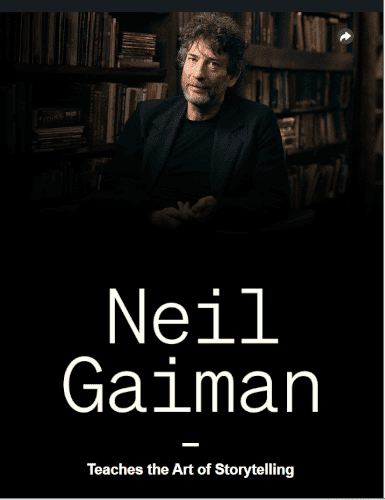
But traditional writing classes are limited in scope, and as Neil put it at the start of his writing masterclass, “The joy of doing something like MasteClass is that I can say the same things I would say to them [my students] to millions of people. <…> I want to show you some of the tools that are hanging on the writer’s toolshed.”
About MasterClass
Since 2015, MasterClass has compiled 180+ online classes from top-tier instructors in almost any field. For one price, it includes pre-recorded MasterClass most popular video lessons from masters such as Richard Branson, Martin Scorsese, Aaron Sorkin, Gordon Ramsay, and many others.
The video quality equals Hollywood movies, and every MasterClass course is carefully structured. But that’s not all. There are homework assignments, a vibrant MasterClass community, and an ever-growing video library to enjoy. The sheer amount of content can make it hard to begin. Cursums Masterclass reviews can provide valuable insights into the right course for you.
Uniqueness and Freshness of the Content
Although there are some articles, interviews, and blog posts of Neil Gaiman’s writing advice, there is no one comprehensive resource. All is inconveniently scattered around the internet and won’t give you the full picture of how Neil Gaiman writes a short story.
Neil Gaiman’s MasterClass is the only place (besides enrolling in Bard College) to get his personal advice on coming up with ideas, editing, and the overall writing process. Even more, this writing course will give you concrete writing exercises for improving your own short stories.
Other popular fiction writer Malcolm Gladwell, might cover similar points. But they also convey a sense of identity built from the many influences they gather over the years. Neil Gaiman’s writing course, coupled with his books, is the best way for any aspiring storyteller to get what’s best from his creative process.
Neil Gaiman MasterClass Review: Content and Structure
Neil Gaiman’s MasterClass consists of 19 video lessons, which add up to four hours and 49 minutes. Each video lesson is, on average, fifteen minutes long, with the longest taking 27 minutes.
You could get through every video lesson in a day or two, but as with all writing courses, the most time-consuming part is homework assignments. The writing exercises will require you to create short stories or one fantasy novel throughout Neil Gaiman’s course. If you are searching for a more direct approach to writing, I recommend checking out the James Patterson MasterClass course for more straightforward approach.
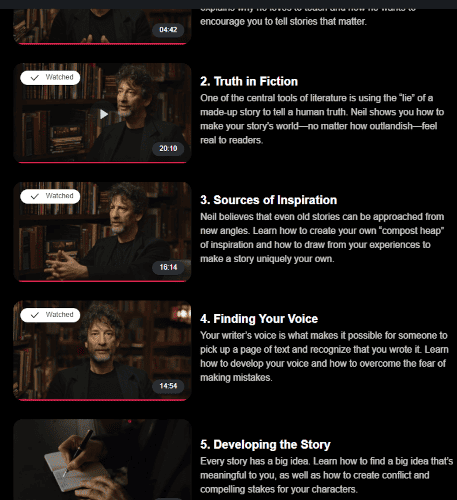
I was able to finish all the writing exercises in a week and a half. But course completion might vary on how well-read you are too. There are a few reading exercises and numerous references to books by other writers, which I’m still reading months after the course completion.
Finding your voice
2-4 Lessons Summary
After the short introductory lesson, Gaiman talks about how writers must use the “lies” of a fictional world to tell the truth about the real one. The first video lessons center around this idea of honesty, giving the student motivation and writing advice.
In the third lesson, Gaiman suggests the metaphor of the “compost heap.” It refers to the practice of collecting seemingly unrelated ideas and combining them to create new ones. It is a way for fiction writers to find inspiration from observing everyday life in their own way.
It naturally leads to the topic of the fourth lesson – finding your own voice. The key idea that Neil teaches is simply to write and embrace the process. Although he always recommends finishing your projects. I found the writing exercises for this part to be really practical.
Developing the story
5-10 Lessons Summary
In these video lessons, Neil Gaiman explains the very beginning of the writing process – how you go from an idea to a story. The fifth lesson sets the ground by asking what these stories and ideas are.
After showing how big ideas can be communicated through character motivations in “The Graveyard Book,” Neil talks about short fiction. They are excellent places to start for a young writer as it is easy to take risks, and the story can start at any point in the narrative.

But fiction writers must remember that writing is still a craft. Even the most magical work, such as Neil’s “March Tale,” is fueled by crafting good protagonists. I found the protagonist worksheet exercise extremely helpful for my writing in the eighth Neil Gaiman’s class.
Next, Gaiman argues that dialogue and character are two legs of the same thing. His writing class suggests starting character development by figuring out how people speak. In the case study of the “October Tale,” Neil suggests using indirect characterization instead of describing characters directly.
Worldbuilding
11-13 Lessons Summary
Next, Neil Gaiman’s MasterClass delves into world-building. Out of all writing classes, these ones are the most oriented to a young writer, as it is where most of us fail at the beginning.
Every fictional world must be grounded in reality, so you should avoid creating fan fiction of other writers and instead take notes from the world outside. Such is Neil Gaiman’s advice to create a “real” yet fictional world.
But an aspiring writer often mistakes descriptions for world-building and makes them sound boring. I found the advice about withholding information and humor in these video lessons extremely valuable for my short stories.
Genre
14-15 Lessons Summary
This section of Neil Gaiman’s Masterclass deals with the genre. But it isn’t just textbook definitions of literary styles. Instead, Neil teaches us to use genres as a framework and subvert the reader’s expectations. The class guide is very useful here as it provides key points about genres from Gaiman’s MasterClass.
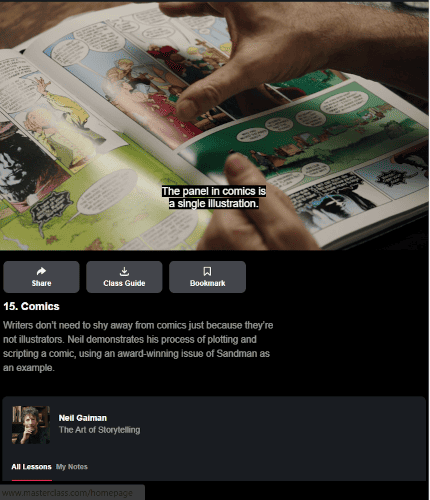
A great example of how Gaiman subverts the genre expectations himself is in his graphic novels. The case study of the Sandman shows the nuts and bolts of how he scripted and plotted this masterpiece. Gaiman discusses how his graphic novel series combine pictures and words to push the genre of comic books to its limits.
The Writer’s Responsibilities
16-19 Lessons Summary
Neil Gaiman’s Masterclass closes with four video lessons covering common problems all fiction writers face. Dealing with writer’s block is the most pervasive one, and all popular writing courses touch on this topic.
Neil Gaiman’s advice is not to think of it as a pain bestowed upon you by the gods. You must try to find out what may have caused it. The Class guide of Gaiman’s MasterClass even provides a couple of good books on the topic.
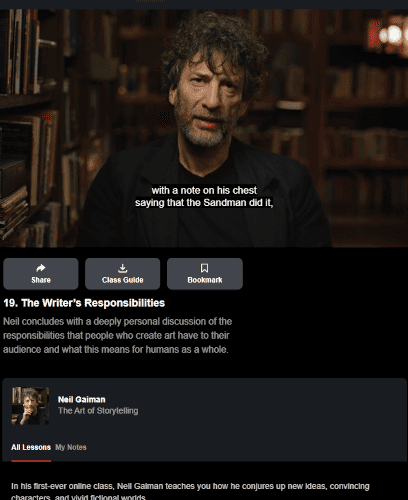
These problems are related to the importance of the editing process and learning to look into your short stories from a new angle. Ultimately, it all rests on the correct balance between humility and confidence, which are the basis of rules for writers proposed by Gaiman.
This balance is crucial for sending a true and honest message through your work as a fiction writer. Only then you can fulfill the writer’s responsibilities and do justice to every point of view in your work.
Fast-Track Lesson Plan
Finish Neil Gaiman MasterClass in 2 hours, 30 minutes, and 15 seconds.
| No. | Lesson | Duration |
| 3. | Sources of Inspiration | 16:14 |
| 4. | Finding Your Voice | 14:54 |
| 5. | Developing the Story | 18:08 |
| 9. | Dialogue and Character | 25:14 |
| 11. | Worldbuilding | 23:00 |
| 12. | Descriptions | 10:15 |
| 14. | Genre | 13:13 |
| 16. | Dealing With Writer’s Block | 13:34 |
| 17. | Editing | 11:25 |
| 18. | Rules for Writers | 12:48 |
Neil Gaiman’s MasterClass: Student Engagement and Retention
As with most courses in Masterclass, Neil Gaiman’s class is visually stunning, with high-quality videos and audio. Although throughout most of the course, Gaiman is simply speaking in front of the camera, similar to writer Margaret Atwood, storytelling. The experience is engaging and left me wanting more. A lot has to do with how personally Neil teaches and how soothing his voice is.
Neil’s videos involve most of what you would expect from a writing course. He introduces engaging metaphors, such as the compost heap, and reads excerpts from his books. All these provide a new light to his books and made me appreciate his graphic novels more.
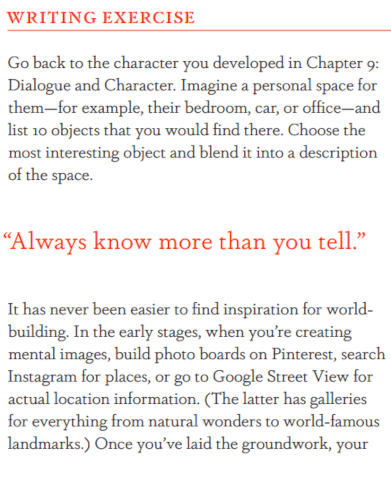
However, the homework assignments in the class guide motivated me the most to continue. It really feels that they are thought-out and resonated well with Neil’s videos. I do not think that any other MasterClass course on writing is better in quality.
My Personal Experience With Neil Gaiman’s MasterClass
Things I Liked About the Neil Gaiman’s MasterClass
94-page Class Guide
I mentioned this a lot in this Neil Gaiman masterclass review, but I’ll say it again – the workbook is incredible. It supplements all writing classes and gives practical homework assignments, charts, worksheets, and even excerpts from Neil Gaiman’s writing. The Class guide alone is worth the money for any aspiring writer.
Balances creative process with professionalism
Neil Gaiman’s class balances professional with creative writing. Too many writing courses either ignore the creativity part or focus on brute forcing your way into publishing. In my opinion, Neil Gaiman strikes a great balance.
Gaiman doesn’t provide any story templates. Instead, he describes a unique approach to the creative process and encourages you to write. I know I have started writing more after Neil Gaiman’s course.
Focus on young and aspiring writers
Neil Gaiman’s Masterclass is primarily geared towards beginners. If you are more experienced in writing, I suggest exploring the lessons of thriller writer Dan Brown. Throughout the course, Gaiman frequently addresses aspiring writers, which can be beneficial for those just starting their writing journey. However, not all viewers are necessarily aspiring writers, which could be a drawback for some. Nevertheless, I firmly believe that Gaiman’s advice is worth considering, even if you have already completed your first fantasy novel.
Things I Didn’t Like About the Neil Gaiman’s MasterClass
No Personal Feedback
Most of what Neil Gaiman teaches about writing is applicable in practice, but it might not be so evident to all. Getting feedback on the writing exercises would open this understanding for more people. To be fair, it’s a lot to ask from Neil Gaiman himself, and the MasterClass community somewhat compensates for this drawback.
Spoilers
Neil Gaiman’s Masterclass draws a lot on his work. He will read short stories, show the graphic novel of the Sandman, and you will get some excerpts in the class guide. It’s all way more enjoyable if you have read the material before. So, before starting Neil Gaiman’s writing course, try reading some of his work.
Is Neil Gaiman MasterClass Worth the Money?
Cost of Neil Gaiman’s MasterClass
Neil Gaiman’s MasterClass cost is the same as for all other courses on the platform. There are three MasterClass annual plans:
| Plan | Price |
| Individual | $10 per month |
| Duo | $15 per month |
| Family | $20 per month |
The family plan is the best value for the money as you can join with friends, which significantly reduces Neil Gaiman MasterClass cost. Your friends are sure to find courses for their taste, as there are over 180 courses to choose from.
I must admit I opted for a MasterClass subscription only because of Neil Gaiman and other courses came as a good bonus. It was totally worth it, as the reading recommendations are still keeping me busy months after.
Does the Class Keep Its Promises?
Definitely! Neil Gaiman presents the tools of his writing process and will motivate aspiring writers to start their journey. The production quality and great presentation of Gaiman himself will keep you engaged throughout the course.
Those expecting a highly practical guide to creative writing will be disappointed. While I found the case studies for the “March Tale” and “October Tale” practically applied, it isn’t what courses for fiction writers usually promise.
Neil Gaiman MasterClass Review: What Others Have Said?
Out of all online courses on writing, the Neil Gaiman MasterClass is one of the most popular. Unsurprisingly, there are tons of reviews and opinions floating around the internet. Most students from Twitter seem to have understood the main message Neil Gaiman sends to his students – find your own voice.
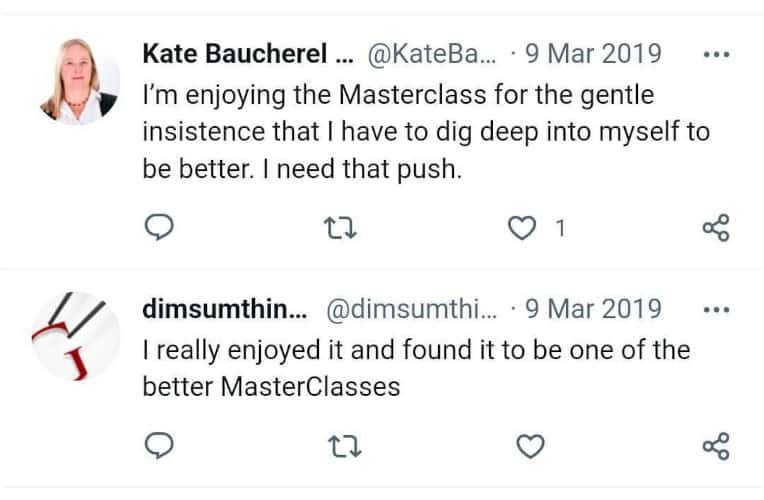
Even those Reddit users who are not the biggest fans of Neil’s writing seem to value his practical and honest writing advice.
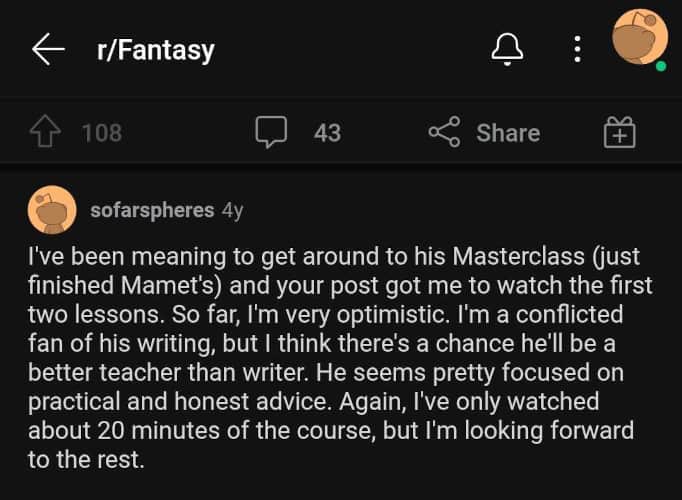
When it comes to engagement, there is nothing better than having a wizard for a teacher. Apparently, Neil Gaiman is just that for users on YouTube.
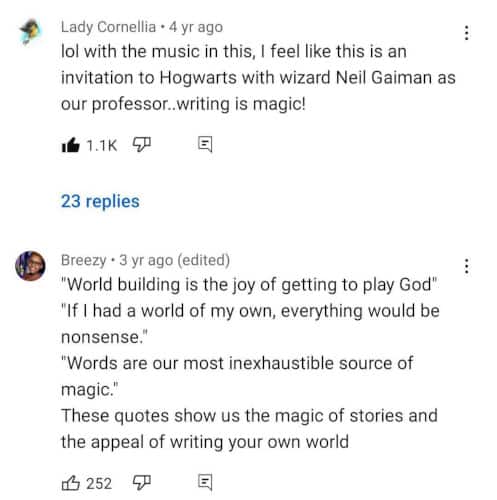
Essentials Used in Neil Gaiman’s MasterClass
You can complete the whole course only with a notebook, pen, and a lot of love for writing short fiction. However, you will get more out of the course if you’ll read these works of Neil Gaiman:
- The Sandman Vol. 1: Preludes and Nocturnes (1988)
- Good Omens (1990), co-written with Terry Pratchett
- The Sandman: Dream Country (1991)
- American Gods (2001)
- Coraline (2002)
- The Graveyard Book (2008)
- The Ocean at the End of the Lane (2013)
There’s a lot more recommended in the class guide, but these books are explicitly discussed in the Neil Gaiman Masterclass. So be sure to read them if you want to avoid spoilers.
Alternatives to Neil Gaiman MasterClass
Other Writing Courses Available on Masterclass
- Amanda Gorman on Poetry
- Billy Collins on Reading and Writing Poetry
- Dan Brown on Thriller Writing
- Aaron Sorkin on Screenwriting
- David Sedaris On Storytelling and Humor
- James Patterson on Writing
- Joyce Carol Oates on The Art of the Short Story
- Margaret Atwood on Creative Writing
- Salman Rushdie on Storytelling and Writing
- Walter Mosley on Fiction and Storytelling
- Shonda Rhimes on Writing for Television
Alternatives to MasterClass
Udemy
Udemy is one of the most popular online learning providers, with a massive choice of writing classes. I recommend looking into Udemy’s Creative Writing Masterclass is a great practical guide on writers’ motivations, grammar, style, publishing, and more.
Coursera
Coursera is another big name in the online courses market, with quite a few on writing. Their Creative Writing Specialization delivered by professors from Wesleyan University even includes a certificate of completion.
Skillshare
Skillshare usually focuses on more practical courses, but their Storytelling 101 course is really compelling and conveniently breaks down storytelling into “4 C’s”. The material is as enjoyable as it is useful.
EdX
EdX aims to connect learners with the best teachers and institutions. Their course series “How to Write a Novel” is led by professors from British Columbia and is definitely worth a look.
The Open University
The Open University is the place to go if you want to get a degree from your home. Their Creative Writing course not only covers fiction, poetry, and scriptwriting but also prepares you for a career in creative writing.
Q&A about Neil Gaiman’s MasterClass

Blogger | Life-long learner
Bill Tremlon
I’ve spent the last ten years passionately studying various online learning platforms. Udemy, MasterClass, Coursera, and Skillshare are the main ones, but I review lesser-known study tools as well. I test and analyze each course and lesson thoroughly before sharing my research.

Blogger | Life-long learner
Bill Tremlon